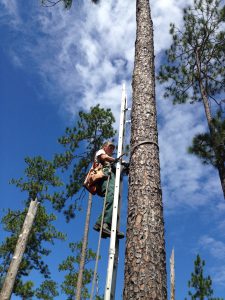
A biologist at Blackwater State Forest monitors endangered woodpecker habitat in a longleaf pine. Photo credit: Carrie Stevenson, UF IFAS Extension
In the Southeastern United States, our forests were once primarily longleaf pine-dominated ecoystems. Frequent summer thunderstorms and their accompanying lightning strikes would routinely set a portion of the forest afire. With plenty of space to move, wild animals relocated to safer portions of the forest or hunkered down in deep, winding gopher tortoise burrows underground. The longleaf pine’s life cycle has co-evolved with fire in such a way that its young growth stage is resistant to fire, and its success as a species requires fire to open up the canopy.
As human populations grew larger in the South, much of that forest land was harvested for timber, pitch, and turpentine, then cleared for agriculture and urban development. The American Southeast now has only 5% of that original longleaf pine forest. Thankfully, continued efforts led by organizations like the Longleaf Alliance and The Nature Conservancy have reminded folks of the species’ importance, and led to conservation and restoration efforts.

University of Florida Extension Agent surveys a planted forest with a producer in Washington County. UF/IFAS Photo: Josh Wickham.
Now, we have a newer mix of forest cover, with specimen trees preserved in parks and yards. In addition, we also have sustainable tree farms. You may have passed a wooded area where you noticed pine trees (mostly loblolly and slash in the south) were in perfect rows—these are being farmed, planted in rows just like any other crops. While they will be harvested eventually, during their lifetimes these trees fulfill all the roles we appreciate in wild forests–animal habitat, oxygen production, carbon dioxide uptake, and cooling via transpiration. The other positive of sustainable forestry is that almost as soon as they’re cut, they’re replaced. Trees are grown in a stepwise fashion to ensure there is always an available harvest. Multiple generations are grown at once to ensure there is rarely a truly bare spot in the landscape.
With 17 million acres in production, forestry makes up the largest agricultural commodity in Florida. When managing, planting, and harvesting trees, modern foresters take tree physiology, invasive species, disease outbreaks, and genetics into serious consideration. These professionals help produce necessary items for life; wood for construction, furniture, books, and the all-important toilet paper, which has emerged as a bartering item in the time of COVID-19. For more information on forestry in Florida, visit the University of Florida’s School of Forest Resources and Conservation.
- Wax Myrtle–a Native Evergreen - December 26, 2025
- Yucca–A Tough and Versatile Native Plant - November 26, 2025
- Blazing Star - November 6, 2025
